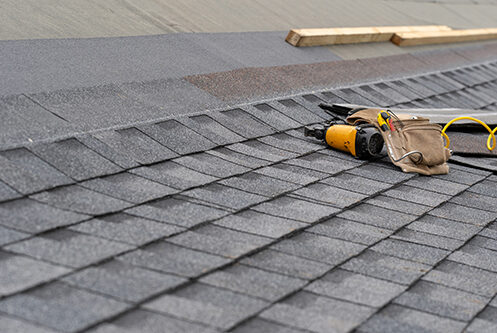If you’re wondering whether to use a hip roof or a gable roof on your Sandersville, GA, home, it’s very helpful to understand the differences between these two styles. Each comes with its own set of benefits and drawbacks.
What Is a Hip Roof Design?
The first hipped roof construction project in the United States dates to 1654, and they’ve been popular since the early 1700s. Hipped roofs are still rather common and were originally influenced by British architectural styles.
There is one flat ridge and four slanted edges on a hipped roof. This roof style can take several forms:
- Hip-and-valley
- Mansard
- Bonnet
- Cross-hipped
- Pyramidal
Benefits
Because the hip roof design is uniform all around the house, it can improve the curb appeal of your property. These roofs are sturdier and more long-lasting because all four sides have an inward slope, which makes their design self-bracing. If you happen to reside in an area that often has strong winds or heavy snowfall, they are an excellent choice.
Downsides
The superior stability and longevity of a hip roof come at a far higher cost than that of a gable roof due to the higher complexity of the design, the higher skill level required for installation, and the higher material cost. It’s also worth noting that inadequate installation of hip roofs may allow water to seep in, especially at the seams and dormers. This emphasizes the need to use a seasoned roofing company for the installation. Another drawback of hip roofs is their lack of attic space compared to gable roofs.
How Does a Gable Roof Work?
Despite the prevalence of hipped roofs, gable roofs continue to reign supreme in America. Most of America’s oldest buildings include gabled roofs, and this architectural style has been commonplace in the United States since the early 1600s.
An understanding of the fundamental construction of a gable roof will allow you to identify it with ease. A gable is a vertical, non-sloping wall that may or may not contain a window or vent. A ridge will run between the summits, and you’ll notice at least two gables and two slopes. A gable roof, in a nutshell, is one in which the three sides rise vertically to form a triangle at the very top.
Like hipped roofs, gable roofs can take many different forms. Here are a few typical types:
- Jerkinhead
- Open
- Dutch Gable
- Cross-gabled
- Boxed
Benefits
Gable roofs are more cost-effective than hip roofs, which is one reason they’re so popular. They also do a great job of diverting precipitation away from your roof. In comparison to hipped roofs, gable roofs are easier to keep clean and in good repair. They also provide more attic space because of the vaulted ceilings they create.
Downsides
Despite their apparent simplicity, gable roofs can be very attractive. Still, a lot of homeowners prefer the uniform appearance of hip roofs.
Gable roofs don’t hold up as well as hip roofs in areas that get a lot of snow each year or storms with strong winds. During hurricanes and other severe storms, a poorly built gable roof can incur significant damage.
If the gable roof overhangs the house’s walls too much, strong winds can enter the house through the overhang and cause damage. As a result, in the worst-case scenario, the roof may come loose.
Differences
The main distinction between a hip roof and a gable roof is the angle of the side slopes. A hip roof has a downward-sloping pitch that meets the walls of the house. A gable roof, in contrast, has just two triangle-shaped slopes, one from the ridge’s apex and one from the eaves’ base.
1. Aesthetics
Hip roofs are visually distinct from gable roofs. However, if you’re looking at a gable roof from the side, you may not be able to tell the two apart. When seen from the side, though, you’ll see that the gables protrude beyond the outer walls. Hip roofs, on the other hand, reveal nothing but slopes from every angle. A hip roof, in the opinion of some, is noticeably more streamlined and modern-looking.
2. Wind and Airflow
Gable roofs are aerodynamic when wind directions are perpendicular to their slope. There will be a lot of stress on the house’s framework if the wind is coming from the side of a gable instead of the roof’s pitch. Hip roofs are better suited for situations where you need to securely guide wind over and off the roof, regardless of the direction the wind is coming from.
3. Longevity
In general, hip roofs outlast gable roofs. This is because the multi-sided slope reduces the possibility of uplifting. Plus, they are laterally braced, whereas the trusses run parallel to each other on a gable roof.
4. Required Care and Upkeep
The roofing materials needed for a hip roof are more extensive, and there are more seams in the roof than for a gable roof. Because of this, hip roofs need more upkeep than gable roofs.
5. Impact on the Environment
Hip roofs and gable roofs both have their advantages and disadvantages when it comes to the environmental effect of your new roof. While gable roofs use less material overall, hip roofs have less empty attic area that needs insulation. Lastly, a gable roof offers approximately double the surface area of a pitched roof, making it the superior option for solar panel installation.
6. Resale Value
It’s more common to find hip roofs in higher-value homes. However, there is no evidence to say whether one type of roof has a higher resale value.
7. Resistance to Water
Both roof styles are great at shedding rain and snow. However, when it rains heavily and the wind is blowing, water can get into the attic through the gable vent on a gable roof. This isn’t a problem with hip roofs. Gable roofs tend to stay very watertight due to their steep pitch.
8. Cost
The cost difference between hip roofs and gable roofs is quite vast. Most hip roofs cost anywhere from $34,000 to $68,000. Gable roofs are much cheaper, ranging from $25,000 to $50,000. Yet, because they are more likely to sustain damage from strong winds, homes with gable roofs may have higher insurance rates in some regions of the country.
Choosing a Qualified Installation Team
You can get a feel for the reputations and customer satisfaction levels of local roofing contractors’ by reading online reviews before you choose a team to install your hip or gable roof. Make sure they are up to par by checking their credentials, which should, at the very least, include licenses, insurance, and references to back up several years of industry experience.
Fraser Roofing, LLC is here to meet all your roofing needs in Sandersville. We offer emergency roofing services, roof repairs, roof replacements, storm damage repair, and gutter replacement. If you need help deciding between a hip roof and a gable roof, contact Fraser Roofing, LLC today.

